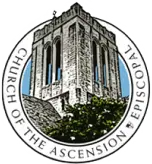From the Rector…
Sit, stand, kneel—or “Pew Aerobics” as Robin Williams called them in his Top Ten Reasons to Be An Episcopalian—are opportunities for intentional engagement in liturgy. The traditional saying goes that “we stand to praise, kneel to pray, and sit to learn.” There is a lot of truth in that.
We stand to praise at various times throughout our worship most notably when we sing or say the Creed. We also stand to praise at the start of our worship—when we greet one another liturgically through the call and response known as the seasonal greeting. This is Episcospeak for the words that begin each service. In Ordinary Time (our current season), the priest says, “Blessed be God: Father, Son, and Holy Spirit.” And the people respond, “And blessed be his kingdom, now and for ever. Amen. “ (Or some form of this greeting depending on the occasion.) We continue to stand through the Collect of the Day. We stand again for the reading of the Gospel. To hear the Gospel is to praise God—we are invited into the story of God and God’s people and the unfolding drama of the building up of the kingdom across the span of history.
We stand for the start of The Holy Communion liturgy. Again, we participate in a call and response between priest and people and then we are invited to make a choice. We can remain standing for the entirety of the Eucharistic Prayer or we can kneel. The choice is not prescribed, but it is hoped that one would understand why they choose to kneel or stand. To stand is highly encouraged in the season of Easter as an early council of Nicaea declared it to be the correct posture for worship in this particular season. As standing is symbolic of praise, that would make sense to us as we see Easter as a season of praise and rejoicing in the resurrection and our salvation. Kneeling is appropriate throughout the year, particularly in Lent, as a sign of prayer and penitence. When making a decision to stand or kneel for the Eucharistic Prayer, invite your posture to reflect your heart. Are you feeling particularly joyous? Then stand. Are you feeling reverent and even penitent? Then kneel. Whatever posture you participate in for the Eucharistic Prayer is then appropriately carried out at the rail and the Post Communion Prayer.
Kneeling is a sign of reverent prayer and penitence. We always kneel for confession and absolution. We can kneel at other times such as the Prayers of the People and the Eucharistic Prayer. It is also appropriate to kneel upon one’s return from communion in reverence of participation in this great sacrament commended to us by Jesus.
During the readings, sermon, and announcements, we sit. In this position, we are invited to listen and learn. We are less prayerful, a moment in which our worship ebbs a bit in order to prepare us for the return of the tide and flow of worship.
We don’t do worship at 100 miles/hour with our hair on fire. We move through the liturgy matching our posture with the expectations of what we might receive from the liturgy and give to God in praise and prayer. Good liturgy is not simply the responsibility of the clergy and altar party. It takes each of us. The more one participates in intentionally thoughtful and meaningful ways, the more liturgy matters to us and those around us. The energy we put into worship is contagious and will grow—inviting all in the pews into God’s glory. Just as we can build up our physical body and strength through exercise, so can we build up our spiritual strength through pew aerobics!
Light and Life,
Candice+
